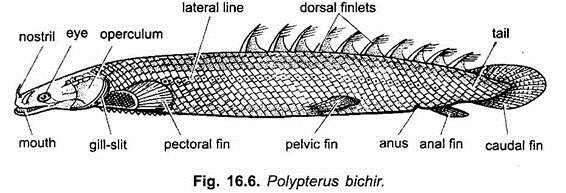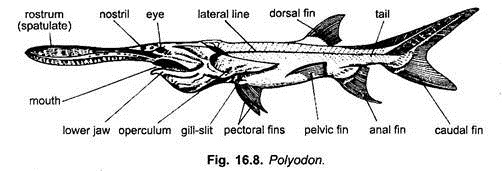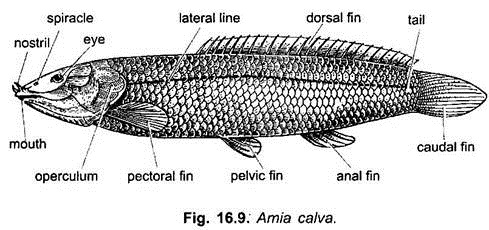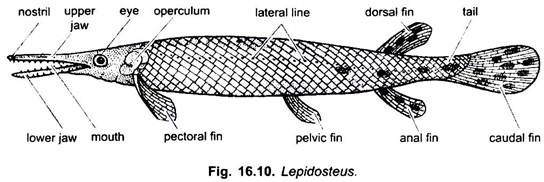In this article we will discuss about the ganoid fish and its types with the help of suitable diagrams.
The actinopterygians (modern living fish) belonging to the superorders Chondrostei and Holostei are known as ganoid fish. They are characterised by having scales covered with an enamel-like ganoin and heterocercal tail fin, i.e., the lower fin-lobe is disproportionately developed and is supported only by hypurals.
It next becomes semi-heterocercal and finally homocercal or more rarely diphycercal. The earlier forms (such as sturgeons, Polypterini, Amia and Lepidosteus), possessed spiracles, abdominal pores, and a spiral valve in the gut. More advanced species have lost these structures. Gills are filamentar type.
The conus in the heart become reduced to one or at most two rows of valves and a prominent elastic bulbus arteriosus has been evolved. The brain structure is characteristic in the large corpora striata, cerebellum and medulla, presence of valvula cerebelli and in the absence of cerebral lobes. The actinopterygians in general show no trace of internal nostrils, (except the stargazer, Astrocopus).
Polypterus:
ADVERTISEMENTS:
Polypterus (Fig. 16.6) along with other ganoid fishes has survived from ancient times. The dorsal fin is divided into a number of finlets, hence, the name. The pectoral fin has acquired a thick scale-covered basal lobe, hence, it was once placed in Crossopterygii, but its endoskeleton is different. Body is covered with thick ganoid scales, dermal denticles like those of elasmobranchs are found on the scales and lepidotrichia.
The tail is no longer heterocercal but appears somewhat diphycercal. Nostrils are dorsolateral, and spiracles persist. It expels water through the spiracles. There is a paired ventral air-bladder which is like a lung, its pneumatic duct arises from the ventral side of the pharynx, the extent to which the air-bladder functions as a lung is uncertain, because Polypterus cannot survive out of water.
The pituitary gland opens into the mouth cavity which is a primitive condition, the spiral valve is well developed. Skeleton has considerable amount of bone and notochord is constricted by bony vertebrae, pectoral girdle has a clavicle and cleithrum, there is a vestigial pelvic girdle. Several species are found in rivers of Africa.
Acipenser:
ADVERTISEMENTS:
Acipenser (Fig. 16.7) is commonly known as sturgeon. It has an elongated snout bearing barbels, mouth is ventral and tubular, jaws are reduced and toothless, sturgeons stir up the mud for suctorial feeding on small invertebrates. The jaws hang free from the hyomandibular. The body has no scales but is covered with five rows of bony dermal scutes which are grooved and bear spines, the heterocercal tail has some ganoid scales.
The spiraches persist, and there are 5 pairs of gill-clefts. There is a reduction of dermal bones and skeleton is almost entirely cartilaginous, but dermal bones form a shield on the cranium, vertebrae are incomplete and notochord is unconstricted.
Sturgeons show some primitive characters of elasmobranchs, such as spiracles, unconstricted notochord, heterocercal tail, conus arteriosus, and a pericardio-peritoneal canal. They also show some degenerate characters in the jaws, scales, and loss of ossification.
ADVERTISEMENTS:
Some sturgeons are found in freshwater but most live in the sea but come to rivers for breeding, they are the largest freshwater fishes, Acipenser huso being 24 ft. and weighing 25 maunds. Sturgeons are used as food and their preserved roe is eaten as caviar.
Polyodon:
Polyodon (Fig. 16.8) is commonly known as paddle-fish or spoon bill. Body is elongated and fusiform measuring up to one and a half to two metres in length. Skin is naked. Bony scutes are absent and ganoid scales are present only on the upper lobe of the tail. The most outstanding feature is the great elongation of snout into a flat oar-like rostrum.
Contrary to the common belief that the paddle or shovel-like rostrum is used to stir food from muddy river bottom. Paddle-fishes are planktivorous. Mouth is wide and ventral. Barbels are absent. Eyes small and open spiracles are present. A small operculum is present. Tail is heterocercal. Polyodon exhibits intriguing geographical distribution. Of the two species, one occurs in the Yantze River Valley of China, the other in Mississippi River Valley of North America.
Amia:
Amia calva (Fig. 16.9) is commonly known as bow-fin. It looks like and has nearly achieved the teleostean condition, it has a long, continuous dorsal fin, hence, the name bow- fin. Mouth is wide with sharp teeth. The scales covering the body have been reduced to cycloid type which overlap slightly but there are still some ganoid scales on the head.
The tail appears homocercal in which the posterior end of the vertebral column is turned up, but externally it has become symmetrical. The air-bladder opens dorsally into the pharynx and it functions as a lung. Amia shows some primitive characters, i.e., presence of a conus arteriosus and a bulbus arteriosus, a vestigial spiral valve and the air-bladder is respiratory.
It shows some advanced characters, spiracles have disappeared, branchiostegal rays are present, and vertebrae are amphicoelous. It is 60.0 cm long and is carnivorous in the rivers and lakes of North America. Eggs are laid in nests and guarded by the male.
Lepidosteus:
Lepidosteus (Fig. 16.10) is commonly known as garpike. It arose in the Permian, flourished in the seas in the Jurassic, and died out in the Cretaceous. Lepidosteus has survived for millions of years without change. It has an elongated cylindrical body covered with an armour of thick, close-fitting ganoid scales, dermal denticles are fused to the surface of scales and lepidotrichia.
There is a long snout or beak having sharp teeth for feeding on fishes. The dorsal fin is far back, tail is a modified heterocercal type which appears nearly homocercal. The air-bladder opens on the dorsal side of the pharynx and is a lung into which the garpike gulps air from the surface. It shows some primitive characters, i.e., a long conus arteriosus, a reduced spiral valve, tail is hemi-heterocercal, ganoid scales over the body, and the air-bladder is respiratory.
On the other hand it shows some advanced characters, i.e., spiracle is absent, pyloric caeca are present, clavicle is lost and maxillae are reduced. The skeleton is ossified, there are dermal bony plates, vertebrae are bony but they are opisthocoelous which is rare in fishes. Lepidosteus is a predator on other fishes, one species in the Mississipi is about 3.0 metres long. They are found in rivers of America and Cuba.




